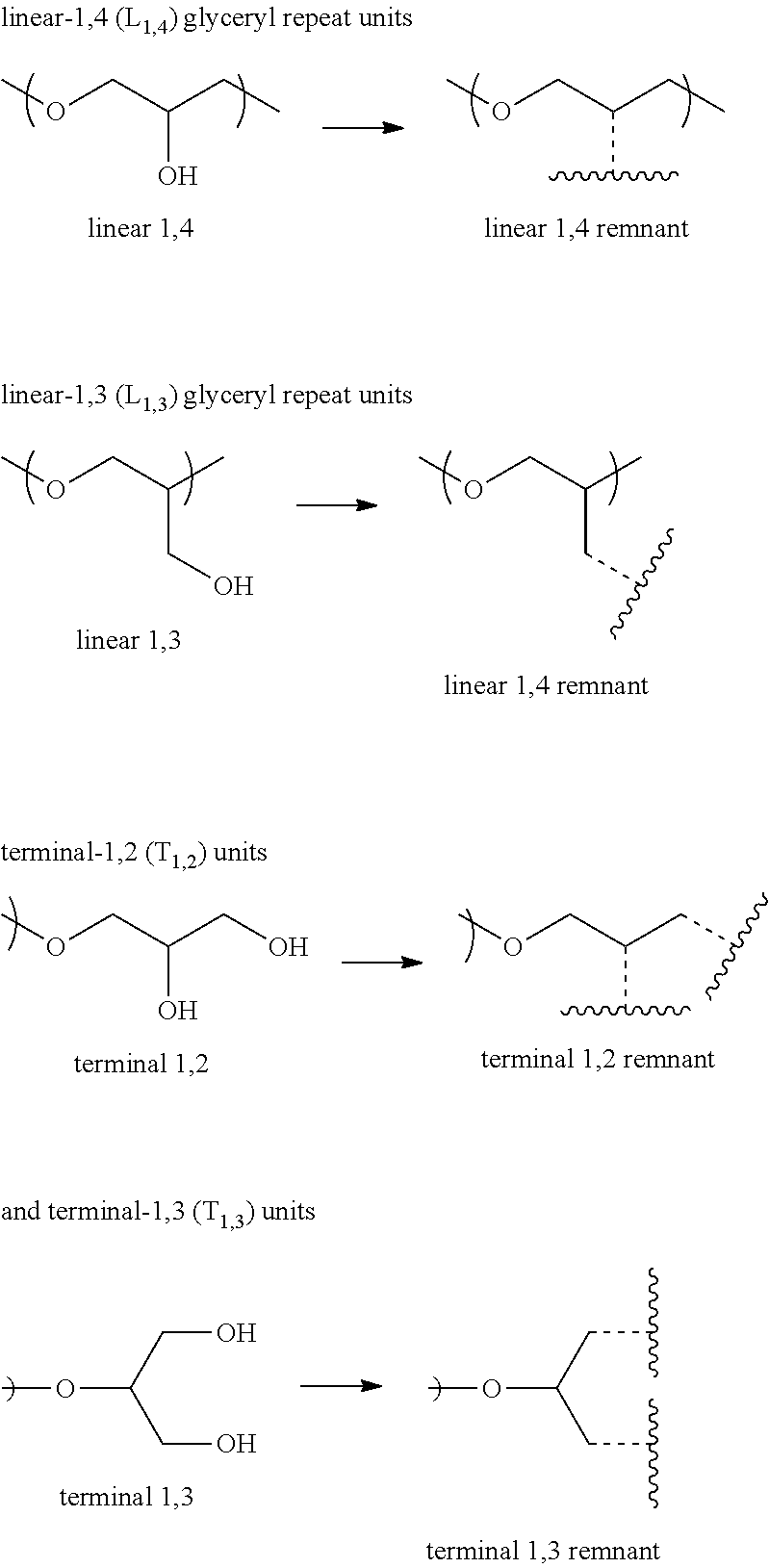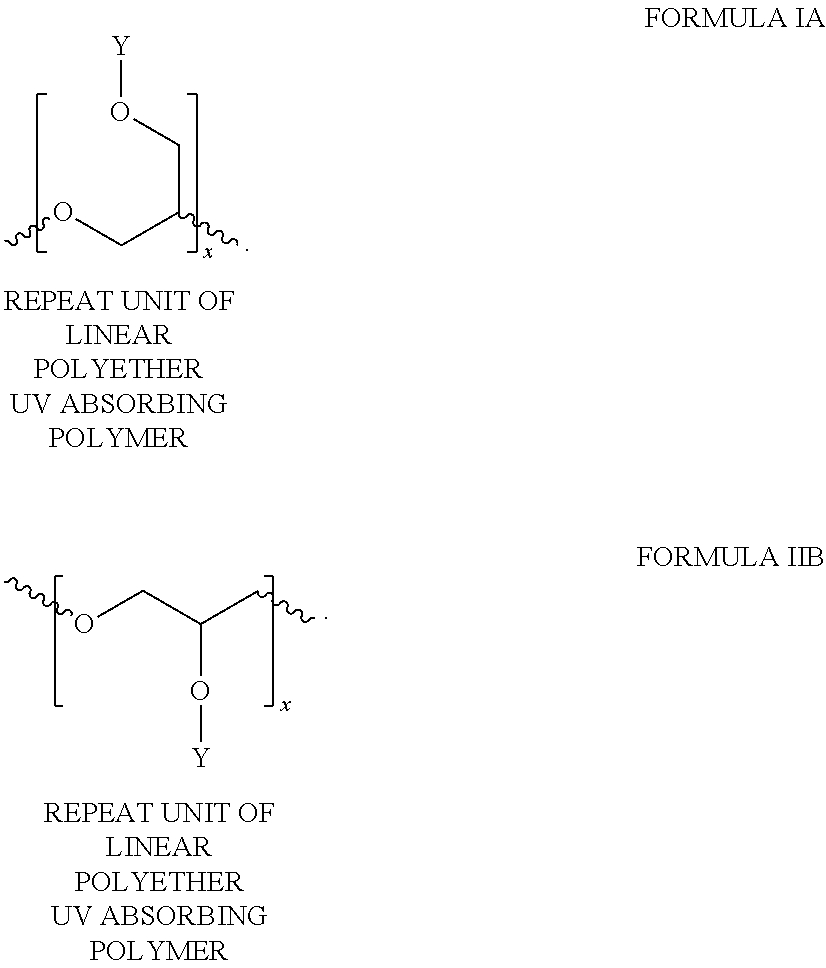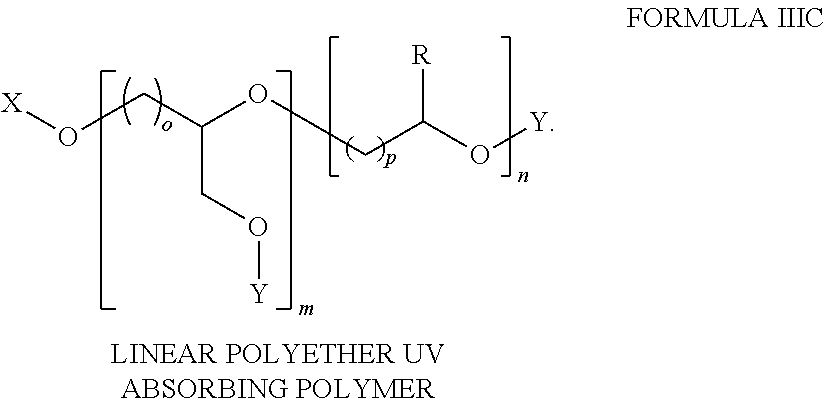Ultraviolet radiation absorbing polyethers
a radiation absorption and ultraviolet light technology, applied in the field of polymer compositions containing ultraviolet light, can solve the problems of accelerating skin aging process, increasing the risk of skin cancer, and formation of light dermatoses and erythemas
- Summary
- Abstract
- Description
- Claims
- Application Information
AI Technical Summary
Benefits of technology
Problems solved by technology
Method used
Image
Examples
example 1
Synthesis of a protected form of glycidol
[0041]
[0042]The synthesis of protected epoxide monomer 1 was performed as illustrated in FORMULA VIII using a variation of a procedure described in the literature (Fitton, A. et. al. Synthesis 1987, 1987, 1140-1142). Glycidol (53 mL, 0.80 moles) and ethyl vinyl ether (230 mL, 2.40 moles; distilled immediately before reaction) were added to a 2-neck 500 mL round bottom flask containing a magnetic stir bar. The flask was fitted with a septum and thermometer adapter; a thermometer was inserted into the adapter and positioned such that the bulb was immersed in the liquid. The flask was immersed in a brine / ice bath; the mixture was magnetically stirred. When the internal temperature was 0° C., p-toluene sulfonic acid hydrate (pTSA•H2O, 1.43 g, 7.5 mmol) was added in small portions while stirring vigorously. On addition of each portion of pTSA, the temperature of the solution increased sharply; the rate of addition was slow enough to prevent the so...
example 2a
Synthesis of linear polyglycerol
[0043]
[0044]Polymerization of protected epoxide monomer 1 was achieved as illustrated in FORMULA VII. 1-Octadecanol (27.76 g, 102.6 mmol) was added to an oven-dried 250 mL 2-neck round bottom flask containing a magnetic stir bar. The flask was fitted with a nitrogen inlet adapter and rubber septum. Potassium methoxide (25 wt % in methanol (MeOH), 6.06 mL, 20.52 mmol) was added to the flask by syringe through the septum. The round bottom flask was immersed in an oil bath which had been pre-heated to 90° C. The septum was pierced with an 18 gauge needle, and the material in the flask was stirred under a constant stream of nitrogen gas for 1 hour, during which time the alcohol melted, and methanol evaporated from the flask. The septum was replaced with a pressure equalizing addition funnel containing monomer 1 (151 g, 1.04 moles). The funnel was sealed with a rubber septum. The monomer 1 was added dropwise to the stirred mixture; the reaction mixture was...
example 2b
Synthesis of linear polyglycerol
[0047]A different batch of protected crude polymer 2 (260 g) and methanol (ACS grade, 1.25 L) was transferred into a 2 L 2-neck round bottom flask. Dry, H+ form acidic ion-exchange resin in (Dowex DR-2030 from Aldrich, 446483; 100.3 g) was added to the flask. The center neck of the flask was fitted with an adapter for mechanical stirring and a paddle; the side neck of the flask was fitted with a water cooled distillation adapter. The reaction flask was immersed in an oil bath. With vigorous mechanical stirring, the reaction mixture was heated to boiling (oil bath temperature of 85° C.). Methanol (and the methyl ether resulting from removal of the protecting groups) was distilled from the flask. After 750 mL of methanol were collected, an additional portion of methanol (750 mL) was added to the reaction mixture. Another 750 mL of methanol was allowed to distill from the flask. Decolorizing charcoal was added to the hot reaction mixture. The mixture was...
PUM
| Property | Measurement | Unit |
|---|---|---|
| Fraction | aaaaa | aaaaa |
| Fraction | aaaaa | aaaaa |
| Fraction | aaaaa | aaaaa |
Abstract
Description
Claims
Application Information
 Login to View More
Login to View More - R&D
- Intellectual Property
- Life Sciences
- Materials
- Tech Scout
- Unparalleled Data Quality
- Higher Quality Content
- 60% Fewer Hallucinations
Browse by: Latest US Patents, China's latest patents, Technical Efficacy Thesaurus, Application Domain, Technology Topic, Popular Technical Reports.
© 2025 PatSnap. All rights reserved.Legal|Privacy policy|Modern Slavery Act Transparency Statement|Sitemap|About US| Contact US: help@patsnap.com



